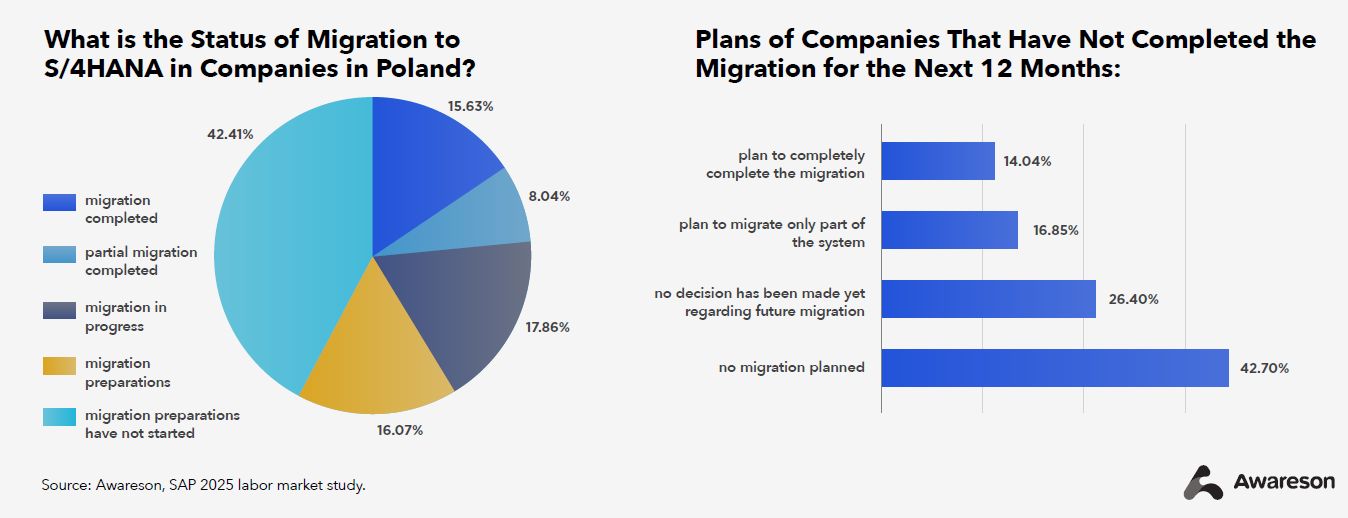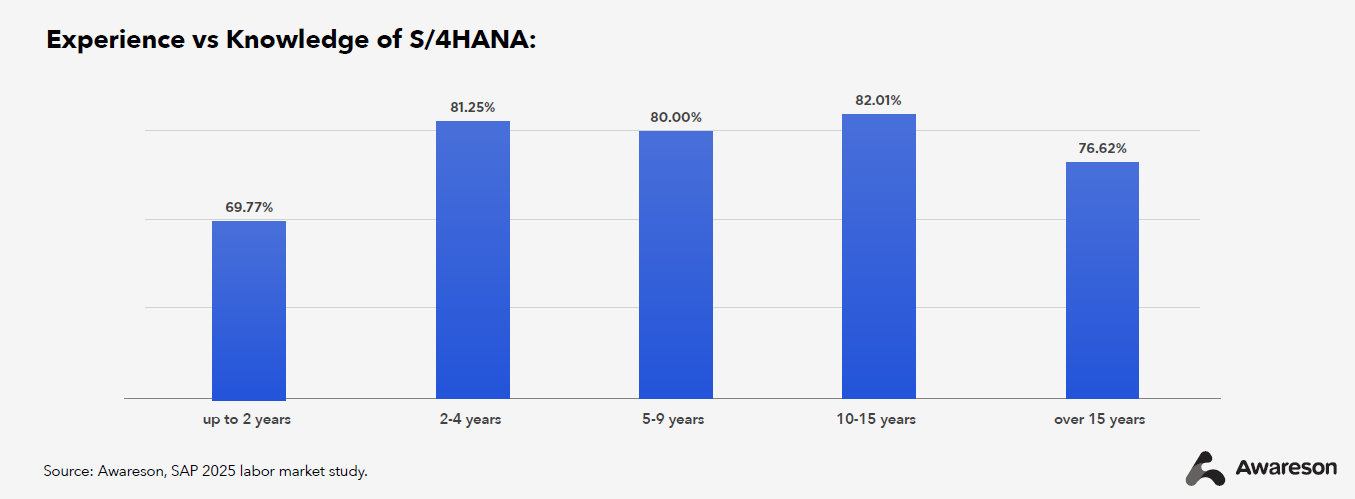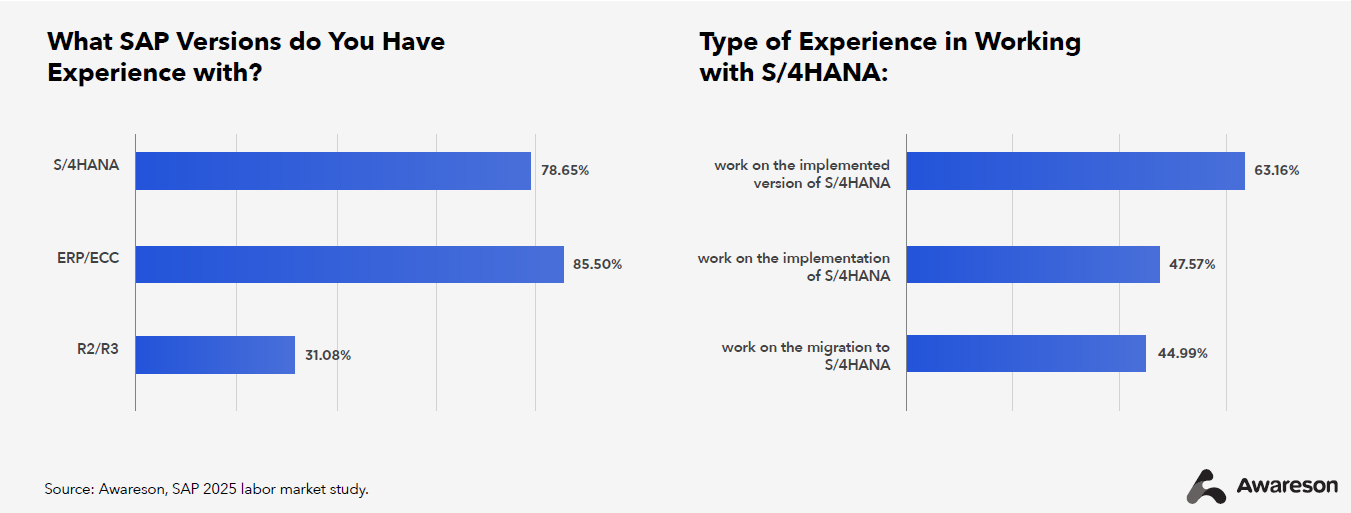S/4HANA and the SAP Job Market

SAP systems have evolved from SAP R/2 (1970s), which supported business processes on mainframes, through SAP R/3 (1990s), introducing client-server architecture, to SAP ERP ECC (2004), which expanded functionalities and business modules. The latest standard is SAP S/4HANA (since 2015), operating on the HANA database, providing better performance, simplified processes, and the SAP Fiori interface.
In 2027, SAP will end standard support for SAP ERP ECC 6.0, meaning no more updates, security patches, or technical assistance.
As a result, companies must plan a migration that requires significant investments in IT infrastructure, employee skills development, and adapting business processes to the modern S/4HANA architecture.
However, SAP users seem to be in no hurry. According to Gartner, as of mid-2024, only about 30% of them had completed the migration. Therefore, SAP has allowed companies that have decided to migrate, but need more time, to opt for extended support until 2030 for an additional fee.
From 2031, older systems will no longer be supported, but large companies will be able to use “SAP ERP, private edition, transition option” – a cloud subscription available until 2033, albeit at higher costs. After this date, on-premise SAP ERP support will end completely.
Migration to SAP S/4HANA is a strategic challenge that companies must prepare for in advance. The end of support for SAP ERP in 2027 means that action must be taken now – seven years for migration for 450,000 companies is actually a very short period. The main problem is the lack of SAP experts, which will increase costs and extend projects. In the coming years, the market will intensively seek specialists, and companies will face recruitment chaos.
Organizations must prioritise internal resources because migration is not just about technology, but also about business decisions. Employees will have to engage in process analysis, testing, and data preparation, which can lead to delays. A lack of resources results in increased costs, stress, and overdue schedules.
To avoid problems, companies should:
1) ask tough questions of implementation partners,
2) train teams,
3) recruit specialists,
4) plan the project realistically.
Only a comprehensive approach will allow for smoothmigration and maintaining a market advantage
Michał Wierzbowski
SAP Business Strategic Advisor at Awareson
Slow Migration to S/4HANA
According to Awareson data, just over 23% of companies in Poland have completed a full or partial migration, and another 17.5% are in the process of doing so. This means that a total of just over 40% of the market is already working or will soon be working on the new version. A similar percentage of companies have not yet started preparations, and 2/3 of them (i.e., over ¼ of all surveyed companies) do not intend to implement the new SAP version for now.
Expensive and Unsure That It’s Worth It
The main reason companies are delaying migration to SAP S/4HANA is the high implementation costs and the enormous organizational effort required to carry out this transformation.

This is particularly difficult for large organizations with complex business processes, using many SAP functions and modules, integrating various IT systems, handling numerous exceptions, having specific reporting requirements, and non-standard authorization models.
One of the key barriers is the lack of internal resources – both experts and teams that can effectively support the transition to the latest version of the system. This leads to problems when working with implementation companies – organizations are unable to keep up with the preparation of key materials, such as data organization or process analysis, as well as with ongoing decision-making, resulting in delays and additional costs.
It is worth noting that nearly ¼ of the companies that currently do not plan to migrate (11% of all surveyed) do not see sufficient business benefits from switching to the new version. They believe that their current solutions fully meet the organization’s needs or do not see any benefit that would justify incurring such costs and organizational effort. Moreover, 14% of current SAP customers are considering switching to ERP systems from other providers or developing their own solutions instead of investing in S/4HANA.

Impact of Migration on the Job Market
SAP S/4HANA is no longer just the future, it is a reality that is significantly affecting the IT job market. Companies are making decisions about migration, which generates new recruitment needs. For SAP specialists, this means there is a need to expand their skills, and for employers – increased competition for experienced experts in this field. There is a growing demand for functional and technical consultants – including developers, architects, and SAP administrators. Both contract specialists, who will carry out the migration, as well as experts, employed permanently in companies that use SAP, are needed to help ensure organization “from the inside” during this process. Requirements for specialists are also increasing – they must acquire new skills to work effectively with the new version of the system.

Over 1/5 of SAP specialists in Poland are people with many years of experience – from the times of SAP R/2 and R/3 to current solutions. These experts have followed the evolution of the system and actively participated in its implementations, both in the Greenfield model (building the system from scratch) and Brownfield/Bluefield (transferring existing solutions to the new version).
Most extensive knowledge of the system is claimed by freelancers (90%) and consulting employees (86%). This applies to both implementation experience and work with the latest version of the system.
2/3 of employees permanently employed in companies using SAP work with SAP S/4HANA, with their activity mainly focused on operation of the implemented version (53%).

58% of SAP specialists intend to acquire or deepen their knowledge of S/4HANA in the next three years. The vast majority of them (83%) report a willingness to participate in implementations. Among the others, there is a predominance of people who are interested in expanding their knowledge of the new version, technical work, learning the system, and obtaining certification.

Despite the dynamic pace at which SAP specialists are acquiring new skills, the market is still struggling with a shortage of qualified experts.
At the same time, many companies are delaying the decision to migrate to S/4HANA. However, organizations that actually remain with the older version of the system must reckon with increasing difficulties in acquiring specialists willing to work with outdated software whose development will no longer be supported.

Increased demand with a limited number of experts is leading to the previously described increase in salaries. It is also worth noting that in the future, the salaries of specialists supporting older versions of SAP will also probably increase, as their skills will become more niche and harder to replace.
Want to know more? Download the full SAP job market report, 2025.
DOWNLOAD REPORT



